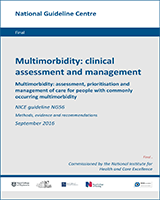NCBI Bookshelf. A service of the National Library of Medicine, National Institutes of Health.
National Guideline Centre (UK). Multimorbidity: Assessment, Prioritisation and Management of Care for People with Commonly Occurring Multimorbidity. London: National Institute for Health and Care Excellence (NICE); 2016 Sep. (NICE Guideline, No. 56.)

Multimorbidity: Assessment, Prioritisation and Management of Care for People with Commonly Occurring Multimorbidity.
Show details3.1. What is a NICE clinical guideline?
NICE clinical guidelines are recommendations for the care of individuals in specific clinical conditions or circumstances within the NHS – from prevention and self-care through primary and secondary care to more specialised services. We base our clinical guidelines on the best available research evidence, with the aim of improving the quality of healthcare. We use predetermined and systematic methods to identify and evaluate the evidence relating to specific review questions.
NICE clinical guidelines can:
- provide recommendations for the treatment and care of people by health professionals
- be used to develop standards to assess the clinical practice of individual health professionals
- be used in the education and training of health professionals
- help patients to make informed decisions
- improve communication between patient and health professional.
While guidelines assist the practice of healthcare professionals, they do not replace their knowledge and skills.
We produce our guidelines using the following steps:
- Guideline topic is referred to NICE from NHS England.
- Stakeholders register an interest in the guideline and are consulted throughout the development process.
- The scope is prepared by the National Clinical Guideline Centre (NCGC).
- The NCGC establishes a Guideline Development Group.
- A draft guideline is produced after the group assesses the available evidence and makes recommendations.
- There is a consultation on the draft guideline.
- The final guideline is produced.
The NCGC and NICE produce a number of versions of this guideline:
- the ‘full guideline’ contains all the recommendations, plus details of the methods used and the underpinning evidence
- the ‘NICE guideline’ lists the recommendations
- ‘information for the public’ is written using suitable language for people without specialist medical knowledge
- NICE Pathways brings together all connected NICE guidance.
This version is the full version. The other versions can be downloaded from NICE at www.nice.org.uk.
3.2. Remit
NICE received the remit for this guideline from NHS England. NICE commissioned the NCGC to produce the guideline.
The remit for this guideline is:
Multimorbidity: Assessment, prioritisation and management of care for people with commonly occurring multimorbidity.
3.3. Who developed this guideline?
A multidisciplinary Guideline Development Group (GDG) comprising health professionals and researchers as well as lay members developed this guideline (see the list of Guideline Development Group members and the acknowledgements).
The National Institute for Health and Care Excellence (NICE) funds the National Clinical Guideline Centre (NCGC) and thus supported the development of this guideline. The GDG was convened by the NCGC and chaired by Professor Bruce Guthrie in accordance with guidance from NICE.
The group met approximately every 5 – 6 weeks during the development of the guideline. At the start of the guideline development process all GDG members declared interests including consultancies, fee-paid work, shareholdings, fellowships and support from the healthcare industry. At all subsequent GDG meetings, members declared arising conflicts of interest.
Members were either required to withdraw completely or for part of the discussion if their declared interest made it appropriate. The details of declared interests and the actions taken are shown in Appendix B.
Staff from the NCGC provided methodological support and guidance for the development process. The team working on the guideline included a project manager, systematic reviewers (research fellows), health economists and information scientists. They undertook systematic searches of the literature, appraised the evidence, conducted meta-analysis and cost-effectiveness analysis where appropriate and drafted the guideline in collaboration with the GDG.
3.3.1. What this guideline covers
The groups that will be covered by this guideline includes adults (18 years and over) with multimorbidity. For further details please refer to the scope in Appendix A and the review questions in Section 4.1.
3.3.2. What this guideline does not cover
The groups that will not be covered by this guideline include:
- Children and young people under 18 years.
- People who only have multiple mental health problems and no physical health problems.
- People with a single long-term condition.
3.3.3. Relationships between the guideline and other NICE guidance
Related NICE guidelines:
- Depression in adults with a chronic physical health problem. NICE clinical guideline 91 (2009).
- Medicines Adherence: involving patients in decisions about prescribed medicines and supporting adherence. NICE clinical guideline 76 (2009).
- Medicines optimisation. NICE clinical guideline NG5 (2015).
- Older people: independence and mental wellbeing. NICE guidance (2015).
- Older people with social care needs and multiple long-term conditions. NICE social care guidance. NICE guidance NG22 (2015).
- Psychosis with co-existing substance misuse. NICE clinical guideline 120 (2011).
- Transition between inpatient hospital settings and community or care home settings for adults with social care needs. NICE guidance NG 27 (2015).
Related NICE guidance currently in development:
- Dual diagnosis: meeting people's wider health and social care needs when they have a severe mental illness and misuse substances. NICE public health guidance. Publication expected September 2016
- Development of the guideline - Multimorbidity: Assessment, Prioritisation and Ma...Development of the guideline - Multimorbidity: Assessment, Prioritisation and Management of Care for People with Commonly Occurring Multimorbidity
Your browsing activity is empty.
Activity recording is turned off.
See more...